Pioneers Rest Cemetery became volume 1 of Fort Worth’s outdoor history books when it was established in 1850 (see Part 1).
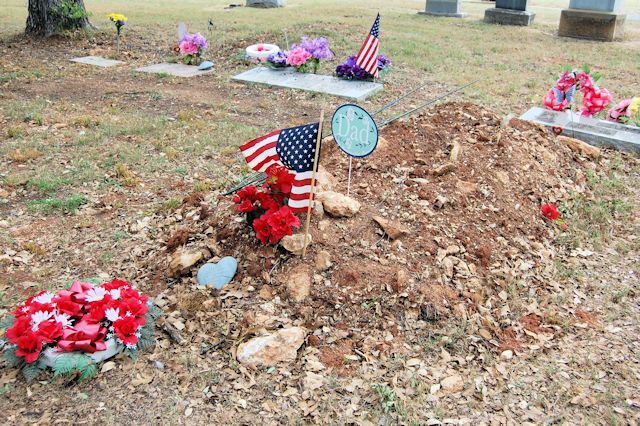 Into its third century Pioneers Rest continues to receive the dead. And just as in 1850, people who dig graves here today face the same stubborn limestone faced by the gravediggers and well diggers of the fort and the early town.
Into its third century Pioneers Rest continues to receive the dead. And just as in 1850, people who dig graves here today face the same stubborn limestone faced by the gravediggers and well diggers of the fort and the early town.
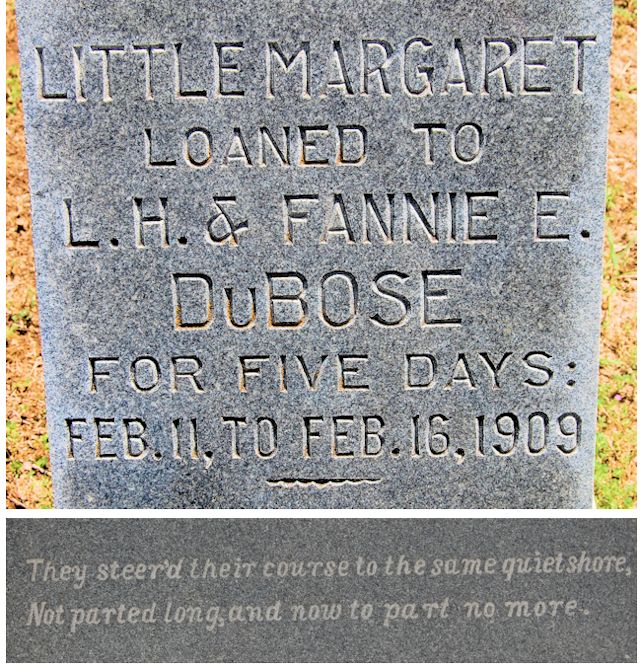 These inscriptions commemorate an infant and a husband and wife.
These inscriptions commemorate an infant and a husband and wife.
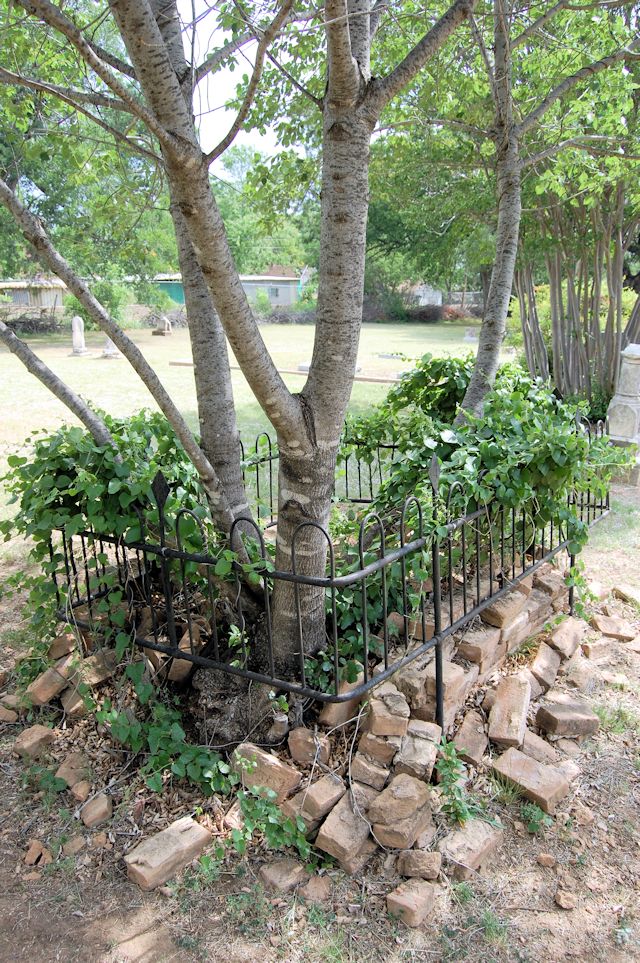 The bereaved of the deceased buried in this lot built a sturdy grave covering of brick and iron. But then along came a seed. And the seed said, “You know, I like this neighborhood. I think I’ll stay and sprout and prosper here.”
The bereaved of the deceased buried in this lot built a sturdy grave covering of brick and iron. But then along came a seed. And the seed said, “You know, I like this neighborhood. I think I’ll stay and sprout and prosper here.”
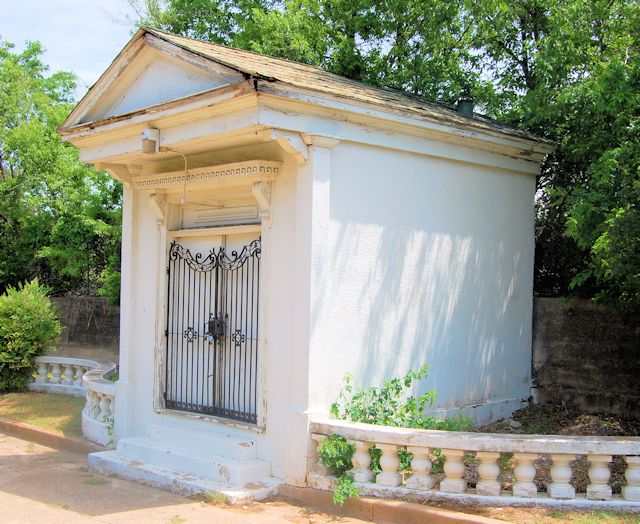 Pioneers Rest is not ostentatious. It has a few family plots surrounded by fancy iron fences and a few marble obelisks but not a single mausoleum. This building is actually a utility shed.
Pioneers Rest is not ostentatious. It has a few family plots surrounded by fancy iron fences and a few marble obelisks but not a single mausoleum. This building is actually a utility shed.
Although many soldiers are buried in Pioneers Rest (see Part 2), it is a mostly civilian cemetery. Civilians buried in Pioneers Rest who are given fuller treatment elsewhere in Hometown by Handlebar include:
• Nat Terry, former president of the Alabama state Senate and a Tarrant County delegate to the state secession convention in 1861, lived on a plantation north of the cemetery. Terry was born the year George Washington was elected president.
• Jesse Shelton Zane-Cetti was a civic leader and president of the Texas Brewing Company.
• Baldwin Samuel gave his name to the neighborhood and land to the cemetery.
• Ephraim Merrell Daggett was a civic leader so esteemed that when the city incorporated in 1873 his image was placed on the city seal.
• Lemuel Edwards settled on the Clear Fork before the military fort was established. His son-in-law murdered him in 1869.
• Dr. Carroll Peak was Fort Worth’s first doctor.
• Merida G. Ellis was a North Side developer.
• Roger Tandy and Arch Hall settled on the prairie of the future East Side in the 1850s.
• Charles Louckx came to Fort Worth from the La Reunion colony and became postmaster.
• Captain Charles Turner, who was among the soldiers who scouted the location for the Army’s Fort Worth in 1849, later operated one of Fort Worth’s first dry goods stores with Ephraim Merrell Daggett.
• Josephine Hirshfield Ryan, daughter of Captain Charles Turner and custodian of Santa Anna’s silver wash basin.
• John Hirschfield was a director—as were Daggett, Khleber Miller Van Zandt, and John Peter Smith—of Tarrant County Construction Company, the consortium that brought the railroad to town in 1876. He was the husband of Josephine Hirshfield Ryan.
 Ewald Henry Keller began making buggies in Fort Worth in 1876. He also sold Studebaker wagons. He lived long enough to make the transition to auto sales and repair. In 1909 he was a local Rambler agent. Clips are from the May 6, 1891 Fort Worth Gazette and January 10, 1909 Telegram.
Ewald Henry Keller began making buggies in Fort Worth in 1876. He also sold Studebaker wagons. He lived long enough to make the transition to auto sales and repair. In 1909 he was a local Rambler agent. Clips are from the May 6, 1891 Fort Worth Gazette and January 10, 1909 Telegram.
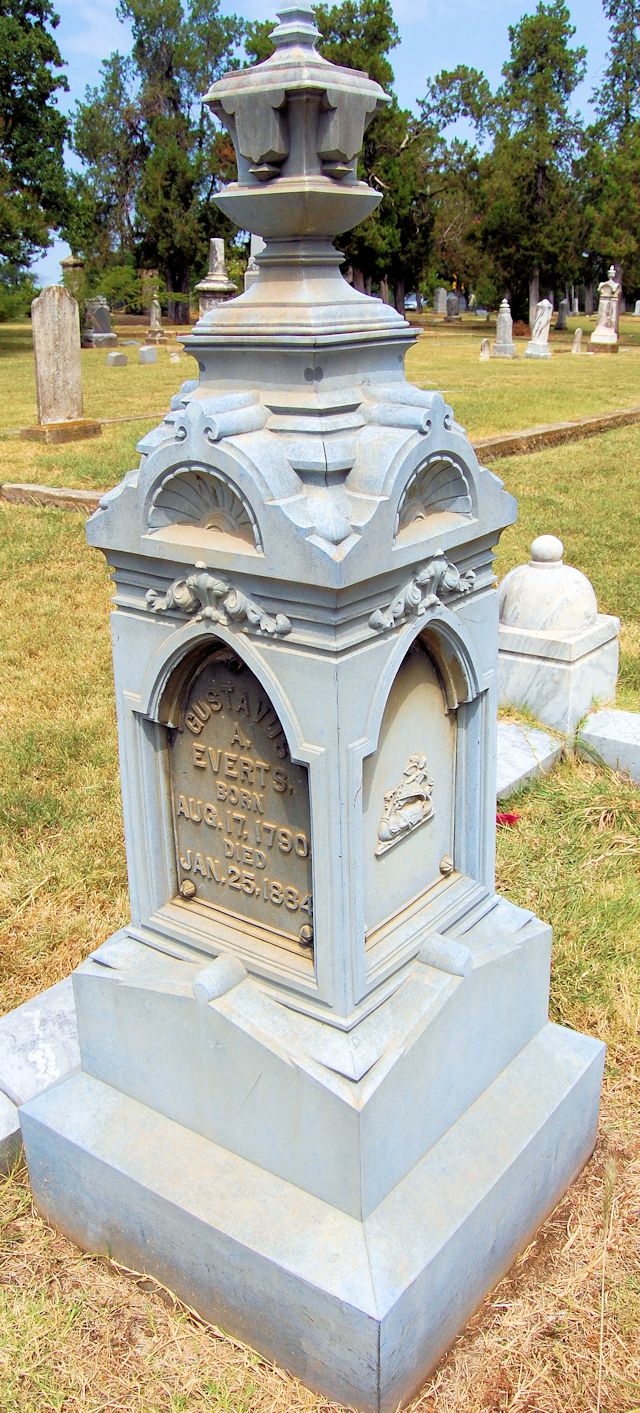 Gustavus A. Everts actually was born in 1797, not 1790. Nonetheless, he has one of the earliest birth dates in a Fort Worth cemetery. Think of the world Everts was born into: a young nation, many of its founders still alive.
Gustavus A. Everts actually was born in 1797, not 1790. Nonetheless, he has one of the earliest birth dates in a Fort Worth cemetery. Think of the world Everts was born into: a young nation, many of its founders still alive.
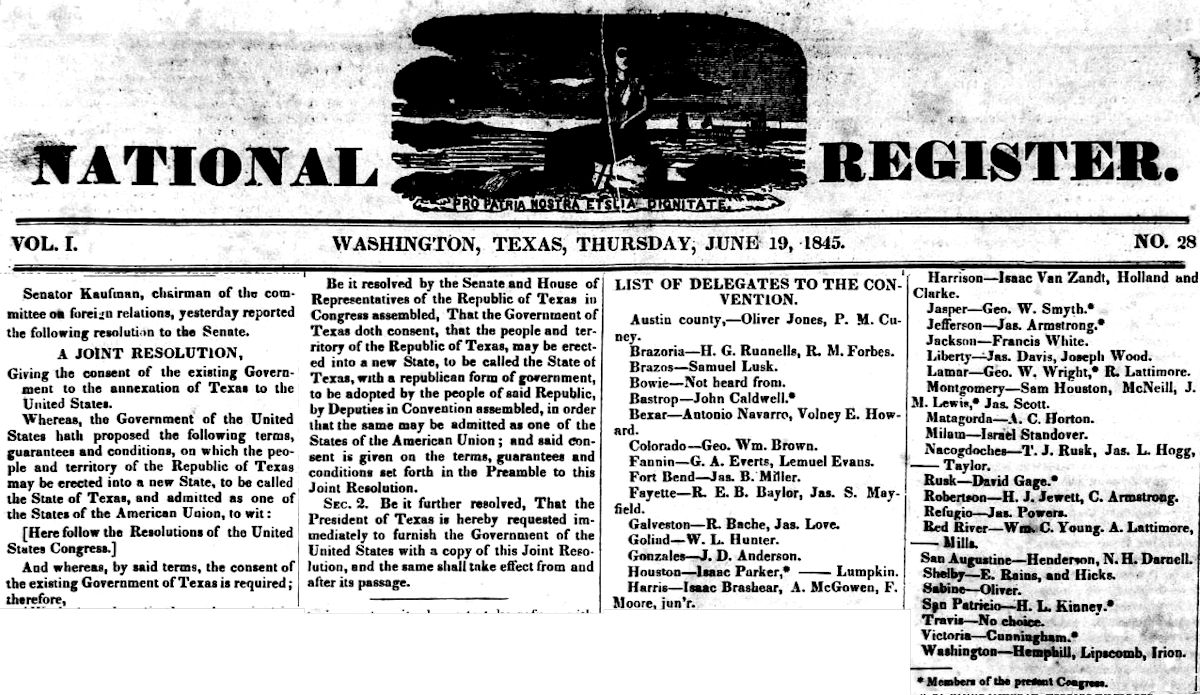 Everts was an attorney. Long before he moved to Fort Worth, he lived in Fannin County during the days of the republic. In 1845 he was a delegate from Fannin County to the convention on annexation and a state constitution when Texas was annexed by the United States. Other delegates to that convention included Sam Houston, Isaac Parker, Isaac Van Zandt, and Thomas Jefferson Rusk. Note that the National Register was published in Washington (on the Brazos), Texas.
Everts was an attorney. Long before he moved to Fort Worth, he lived in Fannin County during the days of the republic. In 1845 he was a delegate from Fannin County to the convention on annexation and a state constitution when Texas was annexed by the United States. Other delegates to that convention included Sam Houston, Isaac Parker, Isaac Van Zandt, and Thomas Jefferson Rusk. Note that the National Register was published in Washington (on the Brazos), Texas.
By 1860 Everts was living in Cooke County. As a Unionist who was opposed to secession, he felt in jeopardy at the time of the Great Hanging at Gainesville in 1862 and fled to Navarro County, where he spent the remainder of the war.
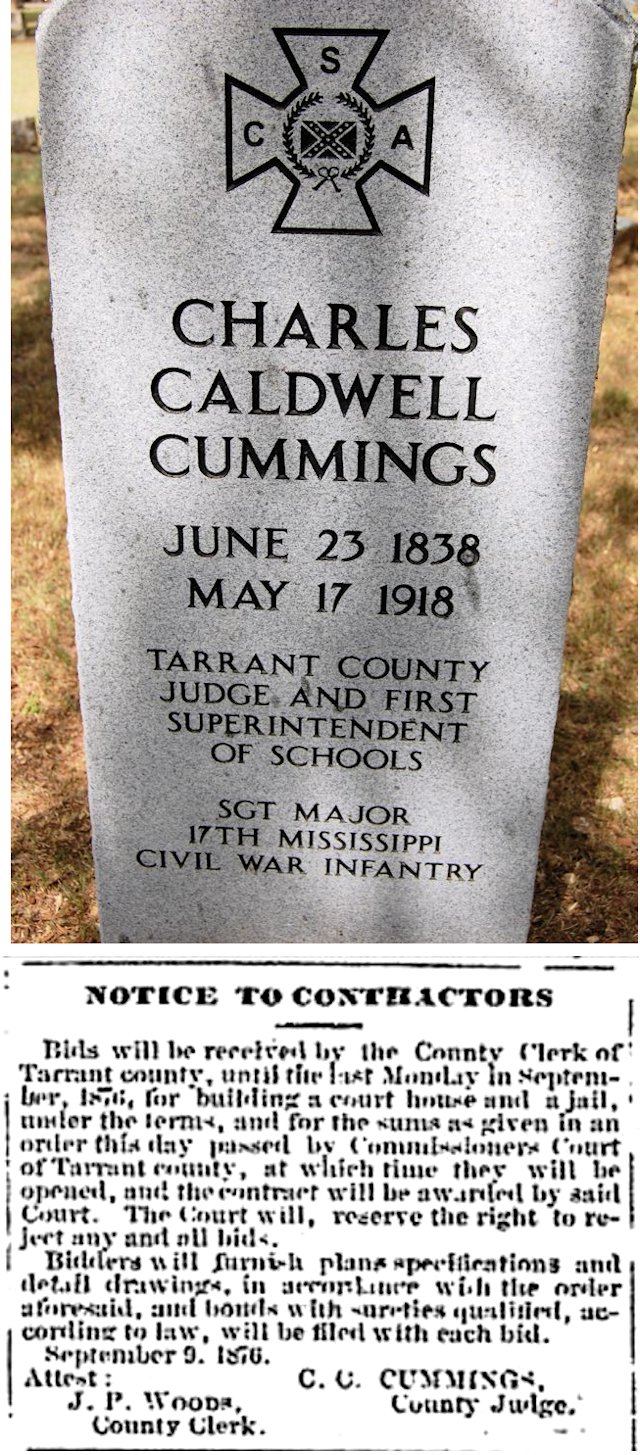 Charles Caldwell Cummings was elected county judge in 1876 after practicing law in Fort Worth for three years. He was one of Fort Worth’s early historians.
Charles Caldwell Cummings was elected county judge in 1876 after practicing law in Fort Worth for three years. He was one of Fort Worth’s early historians.
The courthouse burned in 1876, and the county was taking bids to build a new one. Clip is from the October 11, 1876 Daily Fort Worth Standard.
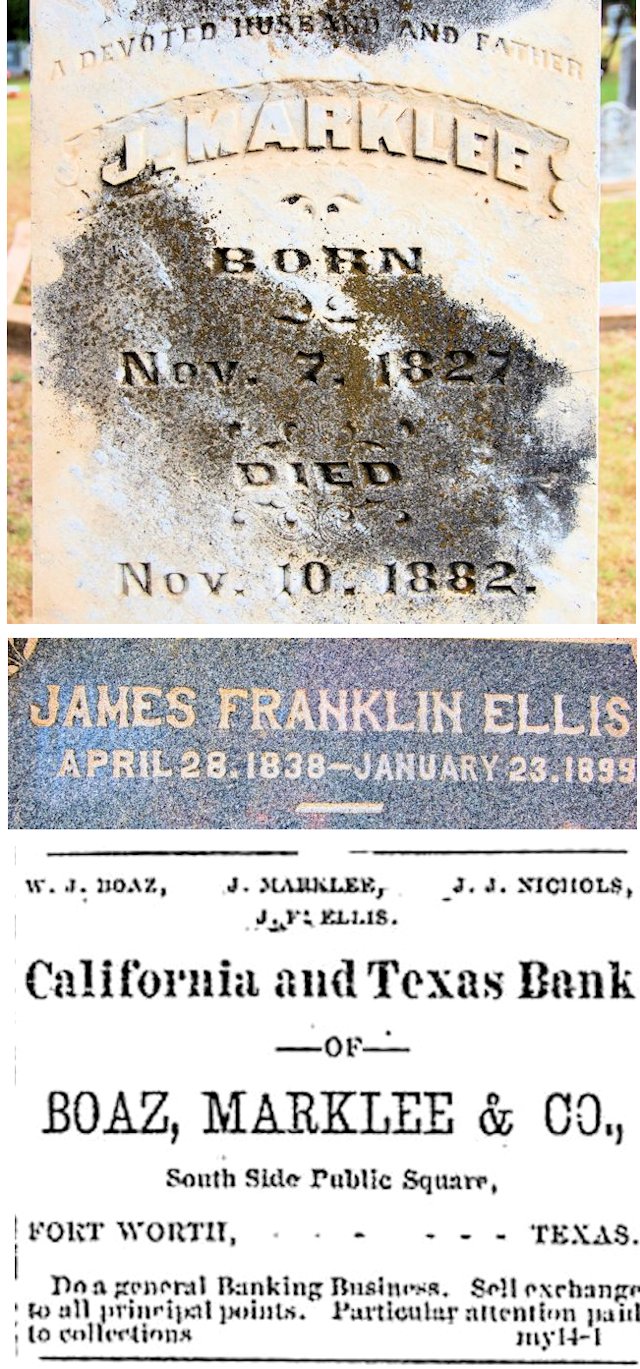 Jeremiah Marklee made a fortune from a gold mine in California in the 1860s, moved to Fort Worth, and with Martin Bottom Loyd founded one of Fort Worth’s first banks. Another officer of the bank, James Franklin Ellis, is buried near Marklee. Clip is from the October 11, 1876 Daily Fort Worth Standard.
Jeremiah Marklee made a fortune from a gold mine in California in the 1860s, moved to Fort Worth, and with Martin Bottom Loyd founded one of Fort Worth’s first banks. Another officer of the bank, James Franklin Ellis, is buried near Marklee. Clip is from the October 11, 1876 Daily Fort Worth Standard.
 John Hanna was a lawyer and teacher. In 1866 he opened a private high school in Fort Worth. He also helped Major Van Zandt start the Fort Worth Democrat in 1871. Hanna also was the judge in the appeal trial of James Creswell, convicted of murdering father-in-law Lemuel J. Edwards in 1869. Clip is from the February 29, 1868 Dallas Weekly Herald.
John Hanna was a lawyer and teacher. In 1866 he opened a private high school in Fort Worth. He also helped Major Van Zandt start the Fort Worth Democrat in 1871. Hanna also was the judge in the appeal trial of James Creswell, convicted of murdering father-in-law Lemuel J. Edwards in 1869. Clip is from the February 29, 1868 Dallas Weekly Herald.
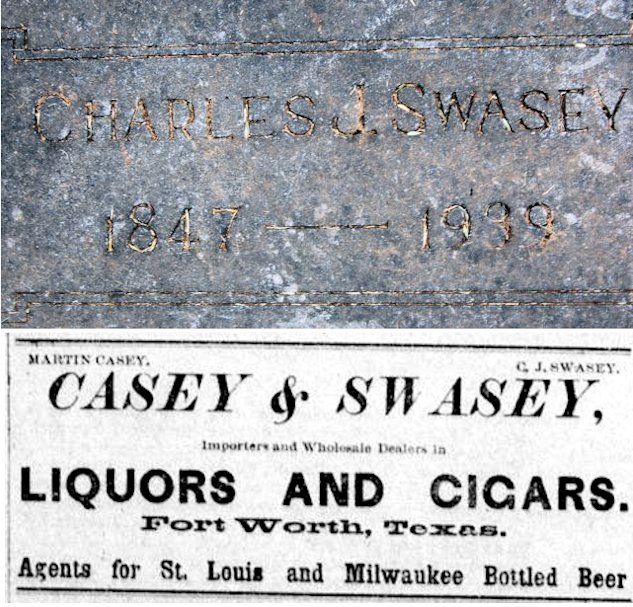 Charles James Swasey lived in Chase Court, was a liquor wholesaler. After the Civil War he had played infield for two early baseball teams: the Chicago Excelsiors and the Forest City Club of Rockford, Illinois. Clip is from the January 24, 1883 Gazette.
Charles James Swasey lived in Chase Court, was a liquor wholesaler. After the Civil War he had played infield for two early baseball teams: the Chicago Excelsiors and the Forest City Club of Rockford, Illinois. Clip is from the January 24, 1883 Gazette.

In 1877 Christopher Columbus Fitzgerald, born about 1848, was serving as deputy marshal under Jim Courtright when Fitzgerald was shot to death while trying to apprehend a suspect. The date on his tombstone is a mystery. He was not born, did not take office, did not die in 1859. And Ed Terrell was the city’s first marshal. In 1869 James Creswell used a pistol belonging to Fitzgerald to kill Creswell’s father-in-law Lemuel Edwards.
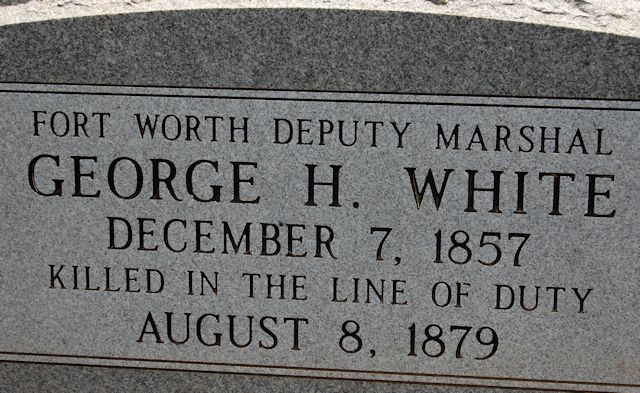 Another Fort Worth deputy marshal, George H. White, was only twenty-two when he was mortally wounded during a shootout with horse thieves near Arlington.
Another Fort Worth deputy marshal, George H. White, was only twenty-two when he was mortally wounded during a shootout with horse thieves near Arlington.
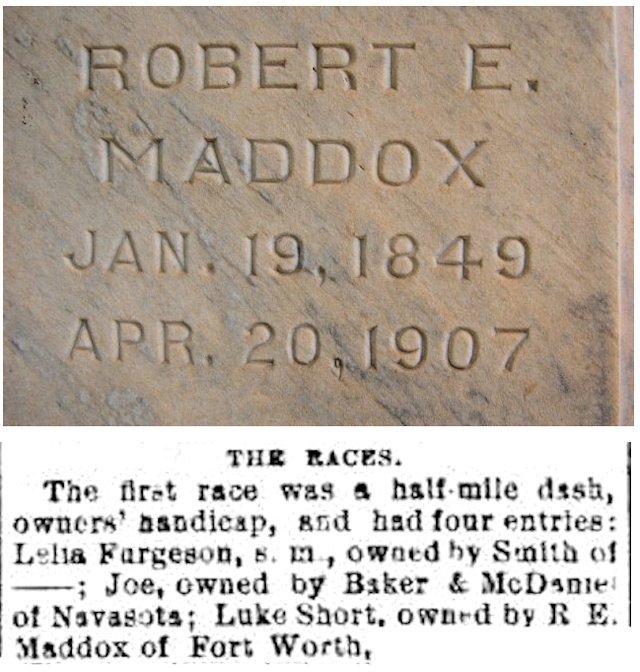 Robert E. Maddox, brother of Sheriff Walter Maddox and City Marshal James Maddox, in 1887 was an organizer of the Fort Worth Union Stockyards Company and in 1885 of the Fort Worth Light and Power Company. He also was city tax assessor-collector. Maddox also raised racehorses, owned a racehorse named “Luke Short.” Clip is from the October 27, 1887 Gazette.
Robert E. Maddox, brother of Sheriff Walter Maddox and City Marshal James Maddox, in 1887 was an organizer of the Fort Worth Union Stockyards Company and in 1885 of the Fort Worth Light and Power Company. He also was city tax assessor-collector. Maddox also raised racehorses, owned a racehorse named “Luke Short.” Clip is from the October 27, 1887 Gazette.
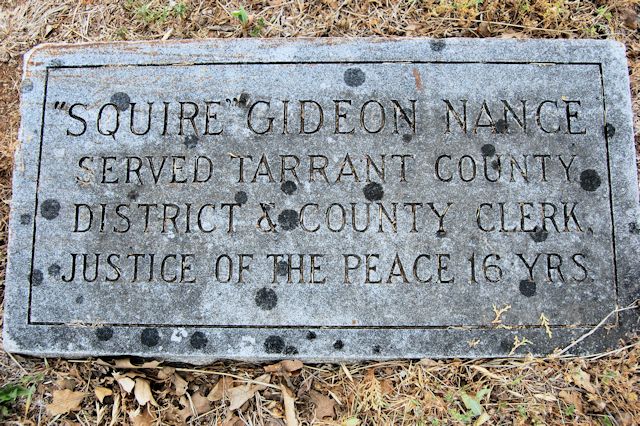
“Squire” Gideon Nance was county clerk from 1856 to 1867.
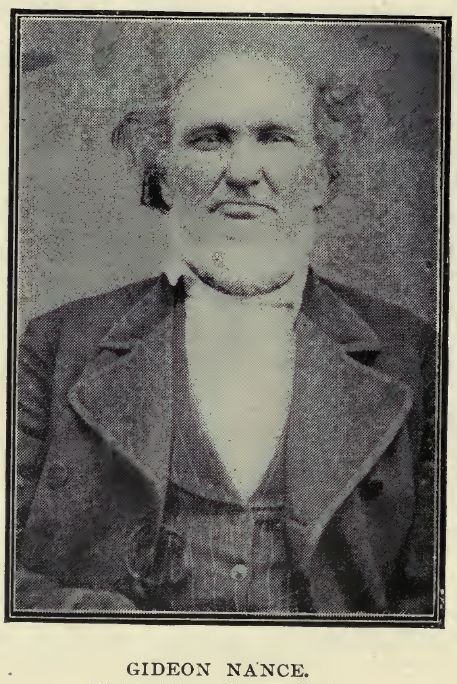 Early settler Howard Peak recalled that during the Civil War, Nance’s name was printed on the county’s currency. (Photo from Early Days of Fort Worth.)
Early settler Howard Peak recalled that during the Civil War, Nance’s name was printed on the county’s currency. (Photo from Early Days of Fort Worth.)
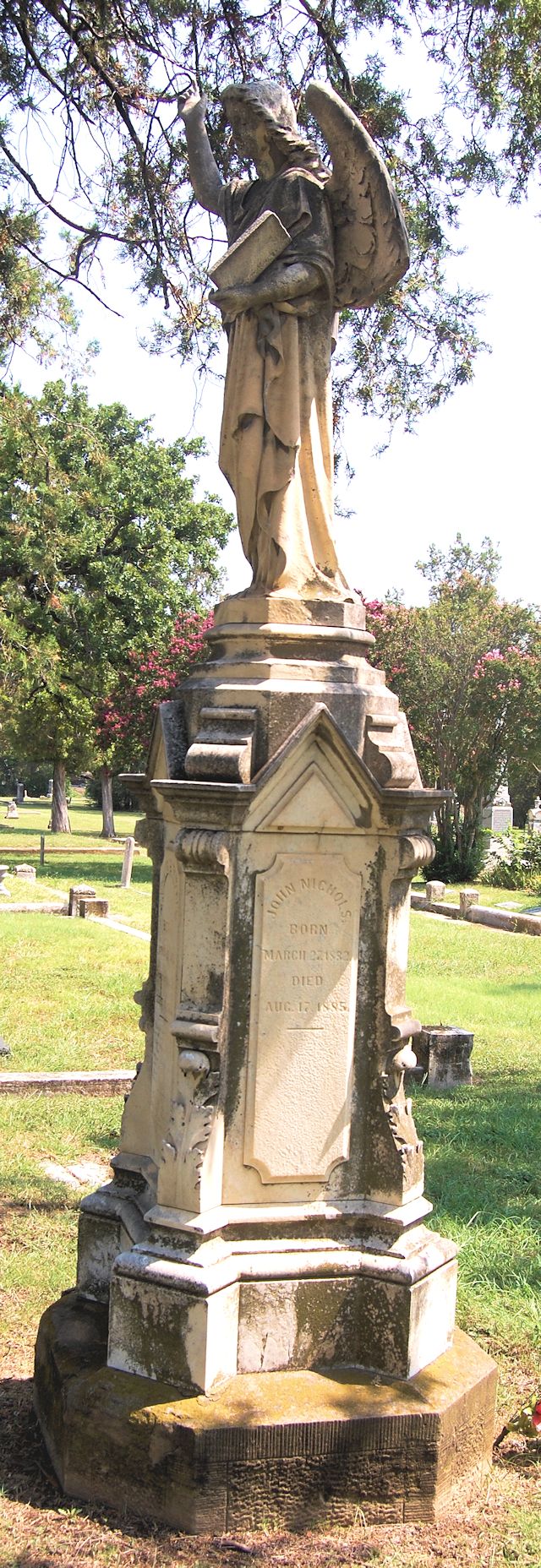 This angel is one of the most striking monuments in Pioneers Rest. But don’t bother to knock: No one is home. According to historian Dr. Richard Selcer, the remains of the Nichols family were moved to Mount Olivet Cemetery and the fragile monument was left behind at Pioneers Rest. This family needed an angel:
This angel is one of the most striking monuments in Pioneers Rest. But don’t bother to knock: No one is home. According to historian Dr. Richard Selcer, the remains of the Nichols family were moved to Mount Olivet Cemetery and the fragile monument was left behind at Pioneers Rest. This family needed an angel:
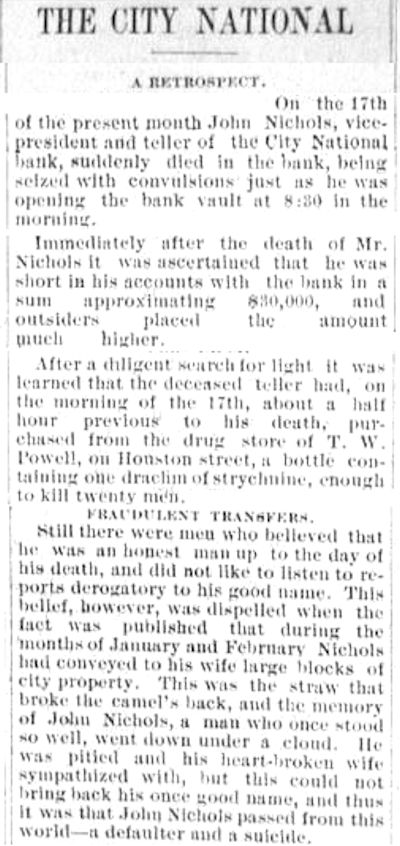 On the morning of August 17, 1885 father John D. Nichols Sr. swallowed strychnine at City National Bank, where he was a vice president. Nichols had also been a city alderman. An examination of the bank’s assets, the Gazette reported, showed that Nichols had been “short in his accounts” at least $30,000 ($760,000 today). Nichols Street on the east side of downtown is named for him. Clip is from the August 29 Gazette.
On the morning of August 17, 1885 father John D. Nichols Sr. swallowed strychnine at City National Bank, where he was a vice president. Nichols had also been a city alderman. An examination of the bank’s assets, the Gazette reported, showed that Nichols had been “short in his accounts” at least $30,000 ($760,000 today). Nichols Street on the east side of downtown is named for him. Clip is from the August 29 Gazette.
 And on December 22, 1906 son John D. Nichols Jr., a special police officer on duty at the Standard Theater in Hell’s Half Acre, was shot to death by a theater patron who was arguing with an employee in the ticket office. The shooter survived and was acquitted on the grounds of self-defense. Clip is from the December 23 Telegram.
And on December 22, 1906 son John D. Nichols Jr., a special police officer on duty at the Standard Theater in Hell’s Half Acre, was shot to death by a theater patron who was arguing with an employee in the ticket office. The shooter survived and was acquitted on the grounds of self-defense. Clip is from the December 23 Telegram.
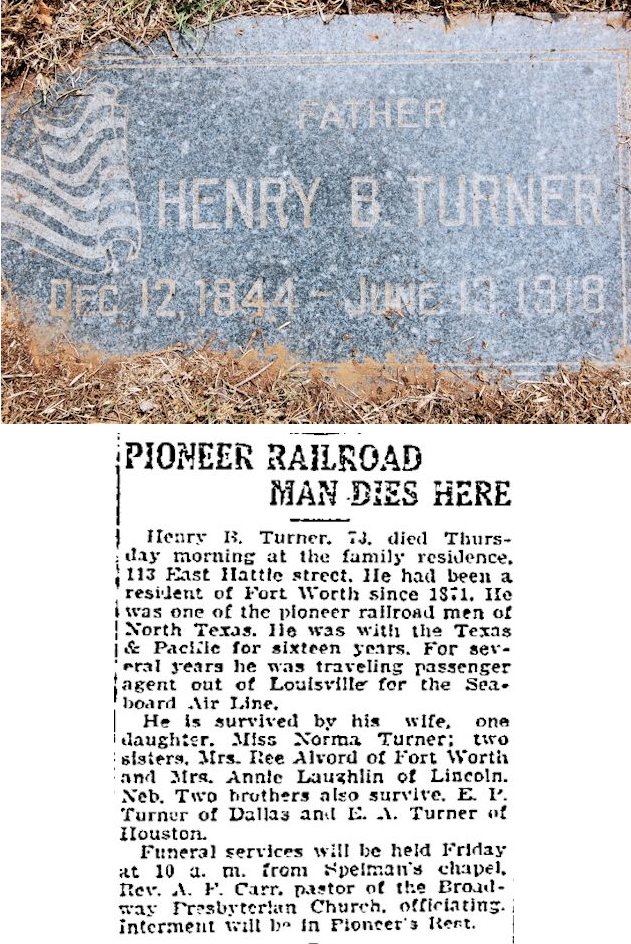 Henry Turner has the first address in Fort Worth’s first cemetery: He is buried in block 1, lot 1. Turner was a Union army drummer in the Civil War and later a railroad worker. Clip is from the June 13, 1918 Star-Telegram. At the other end of the cemetery, at least numerically, is block 4, lot 91. It contains an uninscribed stone.
Henry Turner has the first address in Fort Worth’s first cemetery: He is buried in block 1, lot 1. Turner was a Union army drummer in the Civil War and later a railroad worker. Clip is from the June 13, 1918 Star-Telegram. At the other end of the cemetery, at least numerically, is block 4, lot 91. It contains an uninscribed stone.
From block 1, lot 1 to block 4, lot 91, Pioneers Rest is volume 1 of Fort Worth’s outdoor history books, the story of early Cowtown written on its pages of stone.
(September 2022: Pioneers Rest Cemetery Association seeks volunteers to support Fort Worth’s oldest cemetery. Contact Melanie Smith at (817) 332-8515 or [email protected]. Pioneers Rest Cemetery Association has a Facebook page.)






You failed to mention one of Fort Worth’s founders and Colonel from the civil War, Colonel Abraham Harris. He also is buried at Pioneer Rest Cemetary. The rocking chair that sits in the Museum in the Court House was made by my great, great grandfather, Col. Harris who later gave the chair to Mrs. Peak
Sharon, did you see https://hometownbyhandlebar.com/?p=9814 (Part 1) and https://hometownbyhandlebar.com/?p=9527 on Colonel Harris?